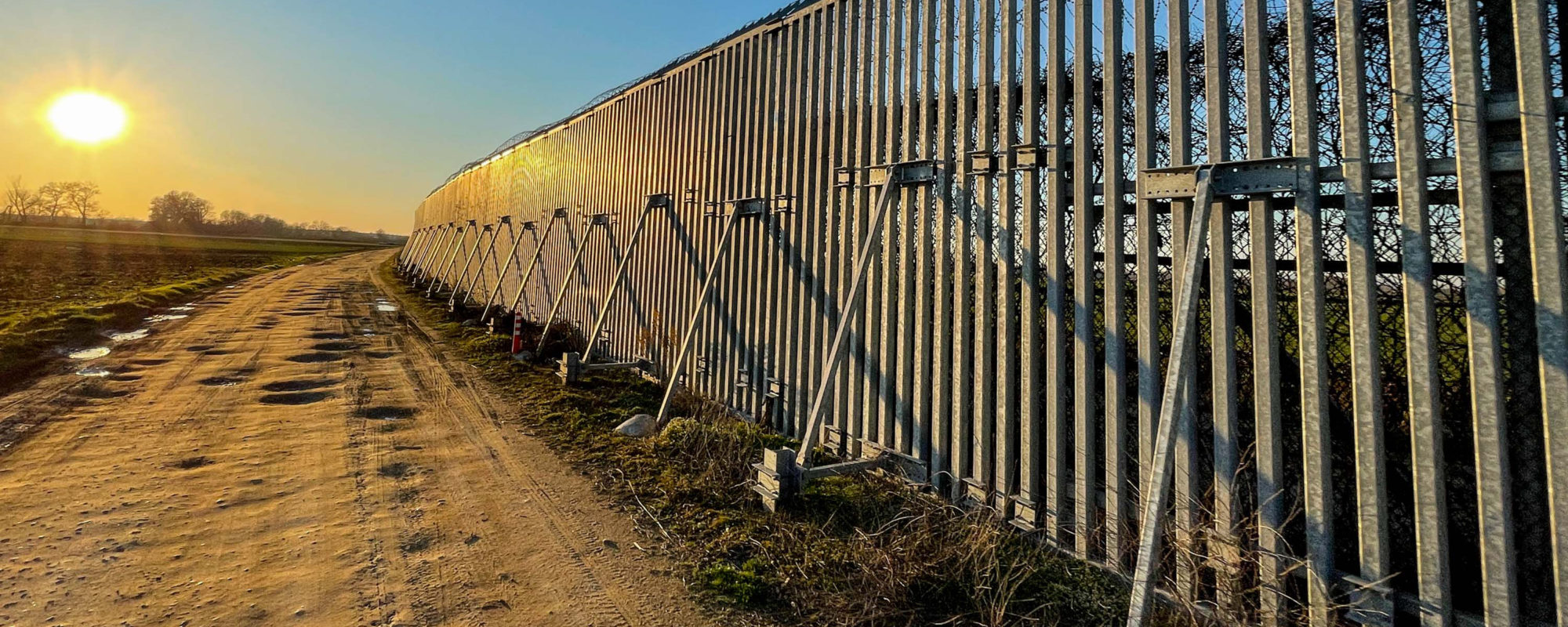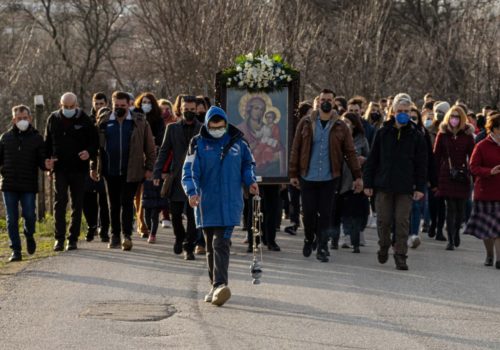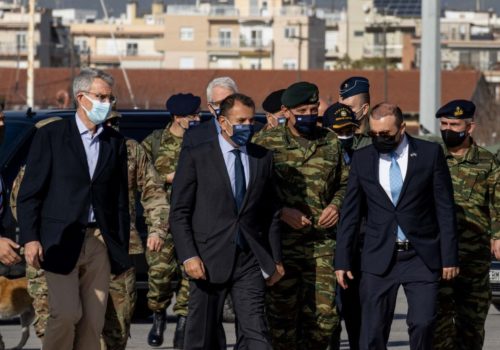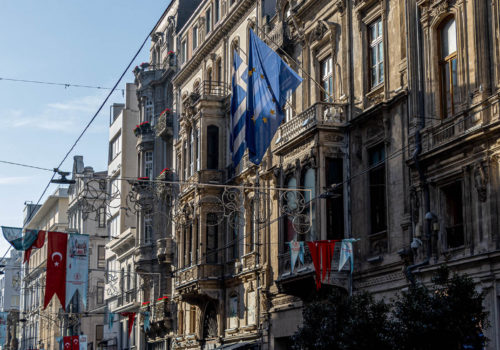KASTANIES, Greece — Two years ago, on the Friday before Clean Monday, which marks the end of the carnival period and the beginning of Lent for the Greek Orthodox Church, Eleni Baharidou and her husband Stefanos, a soldier, were sitting down to dinner at a local taverna when his phone rang. The voice on the other end ordered him to gather his equipment and immediately report to a military camp at the Kastanies/Pazarkule border crossing.
“There was no warning,” said Baharidou, president of a group of civilian volunteers in Nea Vyssa, a village in northern Evros near Kastanies. “They called him in around 11 p.m., and I didn’t know what happened until we spoke on the phone the next day.”
That same evening, 130 kilometers south in the city of Alexandroupoli, Dimitrios Dimitrakopoulos, owner of the Café de Paris, saw all the fighting-aged men in his cafe suddenly stand up and leave after having received word of an incident at the northern land border with Turkey.
It was February 28, 2020, after 33 Turkish troops had been killed by Russian and Syrian airstrikes in Idlib. In an attempt to pressure Europe for greater support, President Recep Tayyip Erdogan made good on his long-time threat to once more inundate the bloc with the thousands of Afghan, Iranian, Iraqi, Bangladeshi, Pakistani and Syrian migrants Turkey had agreed to keep from the border. The Turkish government shuttled migrants from Istanbul and other towns to a border checkpoint named Pazarkule. Many more rushed there when they heard Turkey would allow them to cross unimpeded.
In response, the Greek government sealed its borders and controversially suspended asylum applications for a month, a decision that according to the UN Refugee Agency had no legal basis. Greek Prime Minister Kyriakos Mitsotakis warned migrants not to cross, tweeting, “I want to be clear: no illegal entries into Greece will be tolerated. We are increasing our border security.”
Caught off-guard by the masses gathering in the buffer zone between Pazarkule and Kastanies, local police and army forces struggled to hold the border until reinforcements arrived. “The first 24 to 48 hours were the most critical because we didn’t have the forces we needed,” said Chrysovalantis Gialamas, president of the Association of Border Guards of Evros. “It was unprecedented and clearly directed by the Turkish side, using all those people as a tool for their own interests.”
Greek soldiers blocked the checkpoint with a bus and laid thick loops of razor wire to strengthen their defenses. Working throughout the night, they deterred an estimated 4,000 migrants from crossing and arrested 66. By Saturday morning, there were approximately 6,000 to 7,000 people on the Turkish side of the border. Young men packed into the buffer zone and tried to breach the border fence. They set fires and threw rocks, sticks, smoke bombs and Molotov cocktails, shouting to be let in. Turkish forces assisted, attempting to pull down sections of the fence.
Greek security officers fired tear gas and firefighters doused the crowds with water, while riot police with batons and shields warned them to keep back. “Everything we did to confront the difficulty wasn’t because we’re racists or we don’t accept people who aren’t Greeks in Greece,” Baharidou said. “But a person who comes from a war zone wanting to save his life and his family doesn’t come to break, burn or do such violence. And there were thousands of them, all young men. Where were they planning to go? Realistically, such a thing could not happen.”
Still, the crisis drew scrutiny from groups concerned about the suspension of the asylum process, violations of human rights and attempts by far-right groups to take advantage of the tensions. Shots from the Greek side reportedly resulted in the deaths of Muhammad al-Arab and Muhammad Gulzar, although the Greek authorities insist that only non-lethal means were used.
“This story with the refugees is a tragic story,” Giannis Laskarakis, a writer and former publisher of the left-leaning, Alexandroupoli-based newspaper H Gnomi, told me. “These were dirt-poor people who wanted to go to Europe, as always. And we brought the army with canons and fired at them. It’s unbelievable what happened.”
The incident, which Gialamas refers to as the “Evros war of 2020,” brought this often-neglected northeastern corner of Greece into the spotlight. When European Commission President Ursula von der Leyen visited Evros in March of that year, she affirmed the importance of Greece’s borders as the external borders of Europe and thanked Greece for being Europe’s aspída or “shield.” She also announced 700 million euros in European Union funding for Greece, half of which would be available immediately to upgrade border infrastructure. Frontex, the European border and coast guard agency, deployed an additional 100 guards to the region, while France, Austria, Cyprus and Poland sent additional vehicles and personnel.
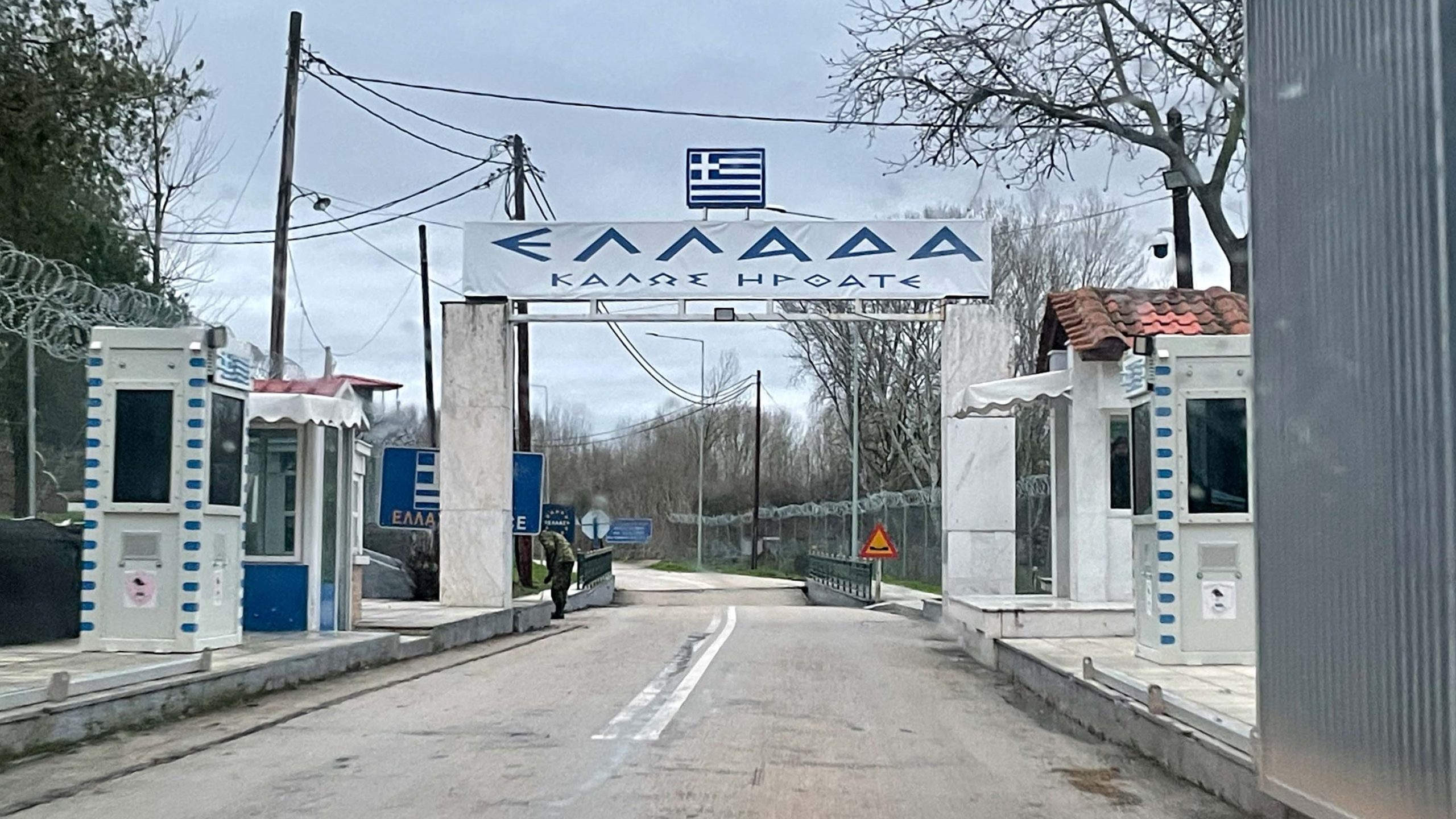
Two years later, Greece has completed the construction of a 40-kilometer galvanized steel fence along its land border with Turkey and plans to extend the fence another 26 kilometers. The border guard force in Evros has been expanded by 400 people, and new technologies are being used to monitor and fortify the frontier. Recent attempts by Erdogan and Belarusian President Alexander Lukashenko to manipulate migrant flows have hardened Europe’s stance on migration, although the EU has offered Temporary Protection to the over three million refugees fleeing Ukraine, 10,700 of whom are now in Greece. Still, it seems as though the rights of asylum seekers from the Middle East and Africa have become a casualty of “Fortress Europe.” I will focus on migration and reports of human rights violations in Evros in my next dispatch.
After speaking with locals who played a role in the “Evros war,” I found that by and large, they were proud of how Greek security forces handled the situation. What surprised me, however, was the strong support of and solidarity with the police and army that locals demonstrated during that time and since. Although many families in northern Evros came to Greece a century ago as refugees from modern-day Turkey, they have joined in a communal effort to protect their homeland and Europe’s borders from new waves of “illegal” migration.
Border villages founded by refugees
I met Eleni Baharidou and two of her volunteers at the observatory in Nea Vyssa, a scenic spot with an old military observation tower, a small chapel and a bunker that overlooks the village and the villagers’ fields. At first, I was a bit unnerved by the sound of gunshots in the distance, but the women shrugged them off. “The military’s probably doing exercises,” Baharidou said nonchalantly. From here, on a clear day, you could see the four minarets of the Selimiye Mosque, a UNESCO World Heritage Site, across the border in the Turkish city of Edirne, called Adrianople by the Greeks.
The Evros, or Meriç, River serves as a natural boundary along most of the 200-kilometer border between the two countries. However, at this point, known as the Karaağaç Triangle, Turkish territory extends west of the river. Greece ceded the territory to Turkey during negotiations for the 1923 Treaty of Lausanne so Ankara would abandon its demands for war reparations.
As a result, some 17,000 Greek Orthodox residents of the triangle, which included the Adrianople suburb of Karaağaç and the nearby villages of Bosna and Demerdes, were forced to abandon their homes during an obligatory population exchange in the summer of that year. In the entryway of the Historical and Folklore Museum of New Orestiada, you can see a blue wagon loaded with agricultural and household goods refugees took with them on their journey. The room also contains ten small boxes of dirt from all the places those people called home.
Residents of Adrianople and Karaağaç established present-day Orestiada, Greece’s newest and northernmost city, while those from Bosna founded the neighboring village of Nea Vyssa. “We chose to live next to the border in the hope that sometime we could return to our land,” Baharidou told me. Today, a 12-kilometer fence separates them from their former homes, stretching across agricultural plots from the Evros River to the Kastanies border crossing point.
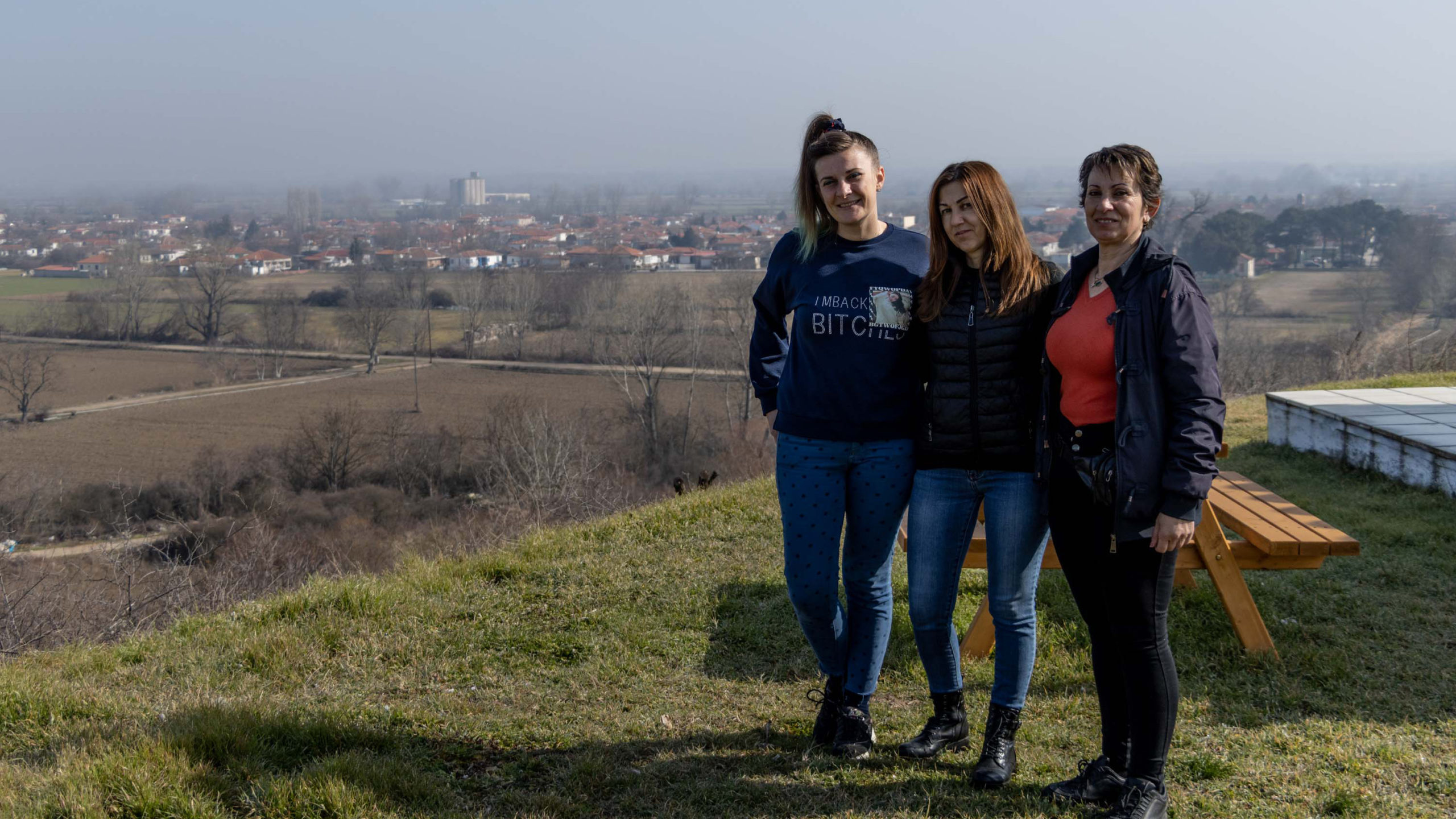
“Children, have you eaten?”
The Nea Vyssa volunteer group, which Baharidou founded in December 2019, has worked to beautify the village and instill in its children a sense of pride and responsibility for their home. The group repainted the abandoned observatory, set up benches and picnic tables and planted pine and plane trees so the area could serve as a meeting place for villagers.
The concrete table where we sat was shaped like a triangle, each side representing one of the three neighboring countries—Greece, Bulgaria and Turkey—and pointing toward the spot where they meet. “It’s a symbol of unity with our neighbors,” Baharidou said. “It’s the megála kefália, the ‘bigwigs,’ who create tensions and problems between our countries. As citizens, Turks and Greeks are friends. Our fields are side by side. We still stop and greet each other.”
On the morning of Saturday, February 29, 2020, after Baharidou had spoken with her husband, she sent out a call to the group to ask who could make a pie or treat they could bring to the forces on the front line.
The following day, the women of the village prepared 420 pies and cakes, filling an entire van. “It was shocking what we saw when we arrived at the guardhouse on the border,” Baharidou said. “Our lips burned from the chemicals, we heard shots, there was smoke. And as soon as our men saw us, their eyes teared up and they thanked us, not because they were hungry but because they felt we were standing beside them.”
Baharidou and her team continued to deliver vanfuls of food and supplies to the security forces, and soon she was receiving donations from all over Greece and abroad. For the next month, people, companies and other organizations sent her sweets, sandwiches, groceries, gifts and even candles for the soldiers and police officers to light at Easter.
It seemed everyone in Nea Vyssa knew someone on the front line. These were their husbands, children and grandchildren. One volunteer, Anastasia “Tasoula” Karlioti, highlighted those close ties. “My younger son finished his military service last month, and it feels like all the children there are our own,” she said. “We give to them, like mothers giving to their sons. That’s why we baked cheese pies, apple pies and sweets. We wanted the guys who were fighting to feel that all the families here were supporting them.”
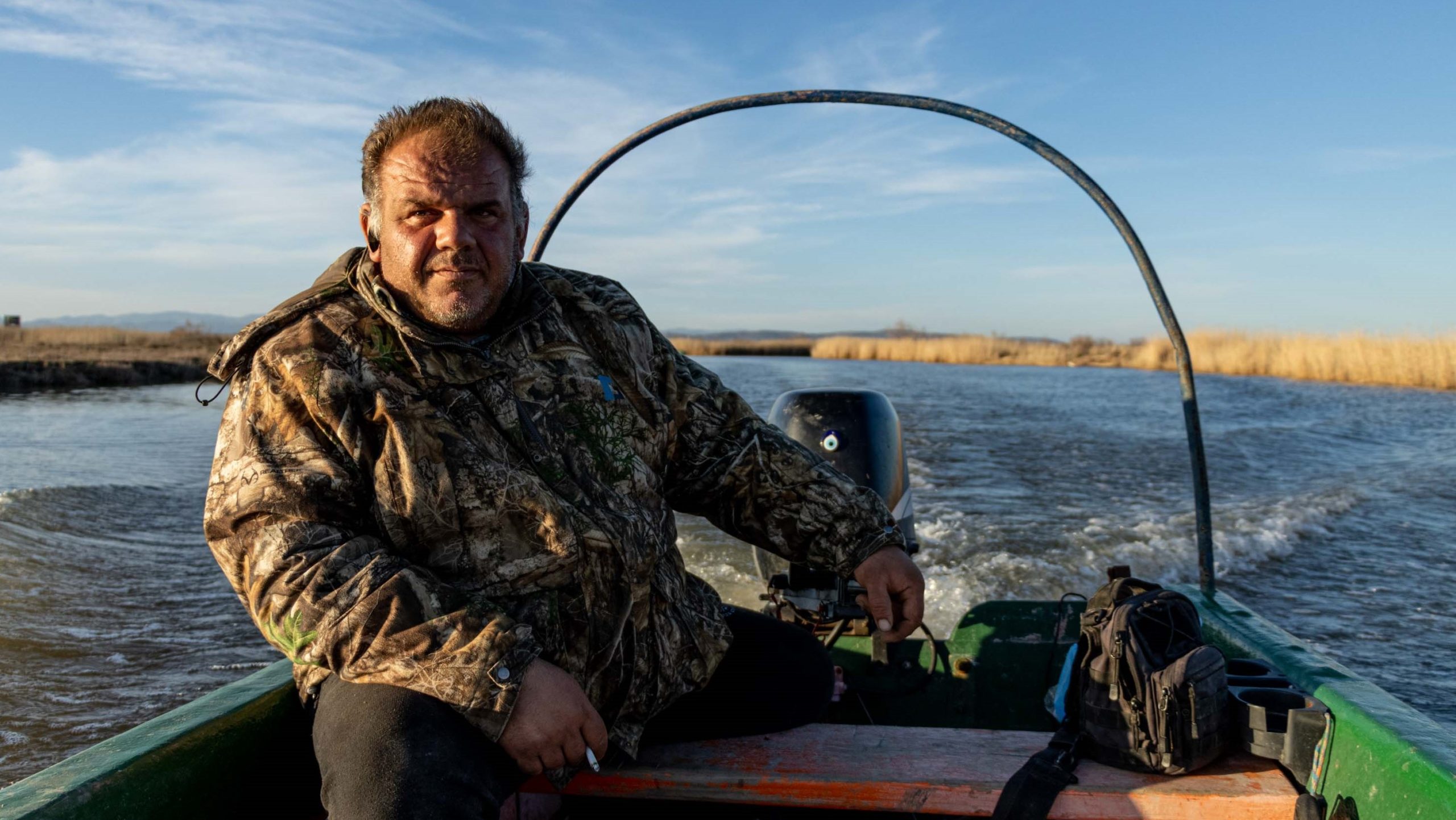
Patrolling the Evros Delta
Athanasios “Sakis” Kamilaris is a big man in a camo windbreaker who pilots his motorboat with a cigarette in one hand. He has been navigating the Evros Delta on his own since he was 11 years old, and he could find his way through its winding canals in his sleep. He followed in his father’s footsteps, working on the delta day and night as a fisherman and guide. This time of year, he usually spends his nights fishing for bass and eels to supply to local distributors.
The night the incident broke out in Kastanies, Kamilaris was at his kalyva, a shack his father had built on the delta in 1974. He received a call from the Greek authorities, asking if he could help. “Many police officers are my friends, local kids I hung out with before they joined the force,” he told me. “If your friend calls you and says, ‘Sakis, I need you,’ you can’t not go. That’s how you’d treat a stranger”—he used the word xénos, which can also mean “foreigner”—“You wouldn’t do that to a friend.” By 2 a.m., a group of about 30 local farmers, stockbreeders and fishermen had gathered to assist the Greek security forces.
As migrants found their path blocked at Kastanies, they began trying to cross at other points along the Evros River. The water level was low at the time since it hadn’t rained, and the river was calm. So the next morning, Kamilaris was out on his boat, serving as the border guards’ eyes and ears on the delta. He reported where he was and what he was seeing. Then he traveled up the river with a police officer, trying to stop people from crossing. “We were successful 95 percent of the time,” Kamilaris told me. “We rescued a lot of people who fell in and didn’t know how to swim. We did this continuously for about 15 days, taking six-hour shifts.”
According to Chrysovalantis Gialamas, president of the border guards, the participation of local fishermen and farmers was crucial in halting incursions of 2,000 to 3,000 people near the town of Feres in southern Evros, where a new section of the fence has been built, and along the river. “Every day, the fishermen from the kalyves of the Evros Delta and the farmers of northern Evros were continuously beside us,” he said. “There aren’t enough thanks for those people.”
However, some believe the fishermen had ulterior motives for offering their assistance. In his opinion piece for H Gnomi, Alexandroupoli resident Giannis Laskarakis wrote, “The illegal inhabitants of the protected habitat of the Evros Delta were out hunting their ‘prey’ and justifying their arbitrary ‘villas’ as defenders of the homeland.” In an interview, he told me, “No one’s going to destroy the kalyves now because their inhabitants claim they’re protecting the border.”
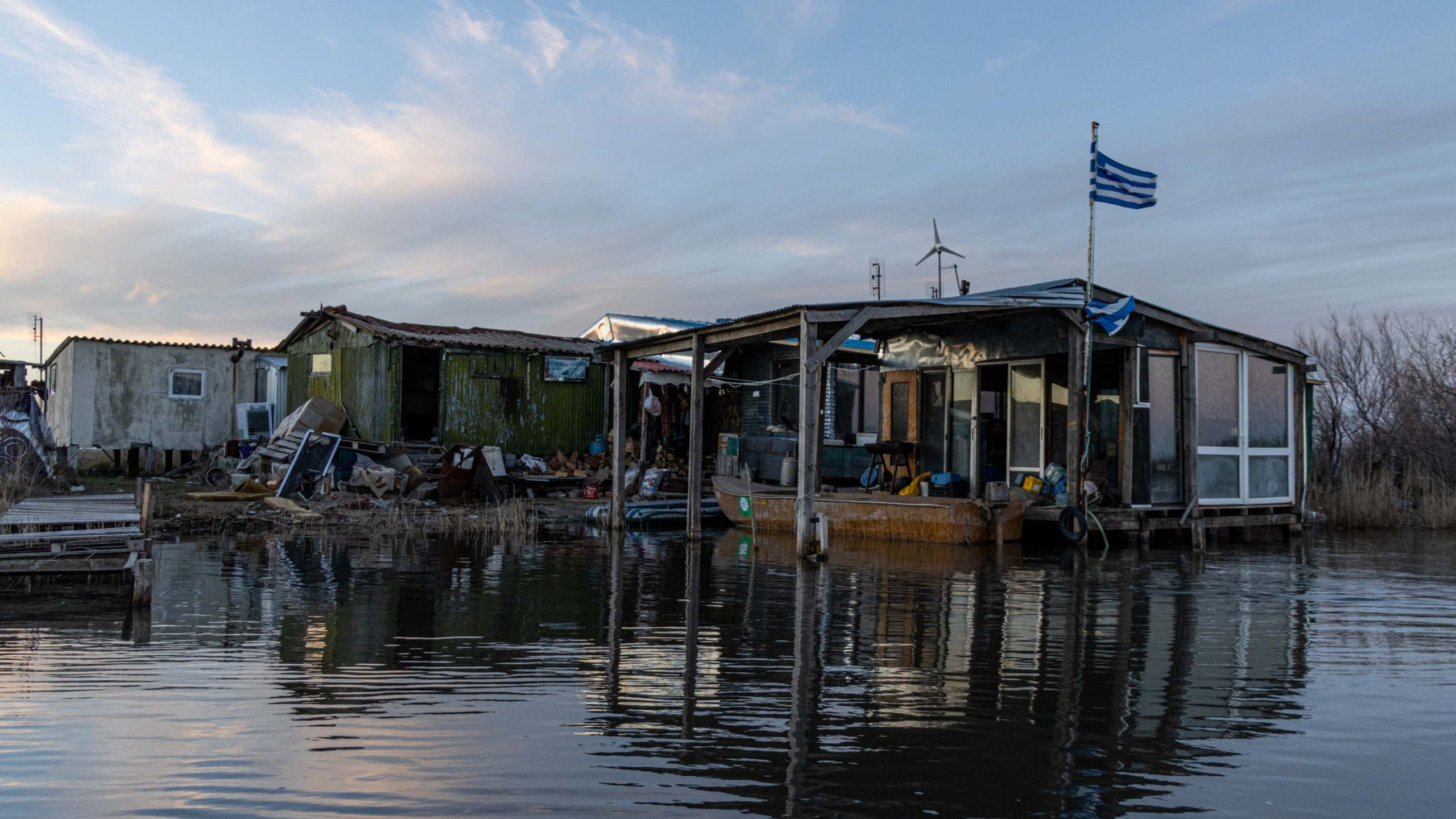
Last month, during a tour of the delta, Kamilaris took me to visit his kalyva. His father made me tea, and I had a chance to poke around while Kamilaris and his best man unloaded ice and other supplies. It was a masculine space, rough but functional, with a heap of trash outside and a half-submerged inflatable raft serving as a dock bumper. Near the door, over a pile of chopped wood, hung waterproof fishing waders. Two dogs lapped up kibble spilling from an open bag.
On the particle-board wall hung two mounted boars’ jaws, a prayer card of the Panagia and a plaque from the Defense Ministry. “We returned and they called us heroes,” Kamilaris told me. “We’re not heroes. We were guarding our homeland, guarding our homes because that’s what we were taught: country, religion, family.”
Nowadays, things are calmer on the delta. Police and military patrol by car and boat, arresting anyone who manages to cross the river. When I asked Kamilaris if I could explore the delta on my own, he told me it wasn’t a problem as long as we were together. “Whichever officers come here, they know our names and we know theirs,” he said. But he also warned me to make sure I was carrying identification. Indeed, as I returned home along the dirt embankment after sunset, my headlights illuminated a herd of brown cattle, a lone grazing horse and then a patrol car waiting in the dark.
A visit to the new border wall
With his bright orange uniform and his name emblazoned on his white van, electrical engineer Sardanis Zisis was easy to spot in Orestiada’s central square. He had offered to drive me along the length of the border fence from Nea Vyssa to Kastanies and tell me about some of the deterrent measures that had been put in place along the border since the crisis of 2020.
We passed through Nea Vyssa, where Zisis’s mother lived alone in the single-story home he grew up in. Many of the houses here were closed, abandoned or overgrown, their inhabitants having died or moved elsewhere. Zisis told me that before the new fence and increased border patrols, there had been incidents of migrants stealing cars or sleeping in abandoned houses. “People feel safer now,” he said. “If it weren’t for the episode in 2020, I don’t think all this work would’ve happened. We would be as we were before.”
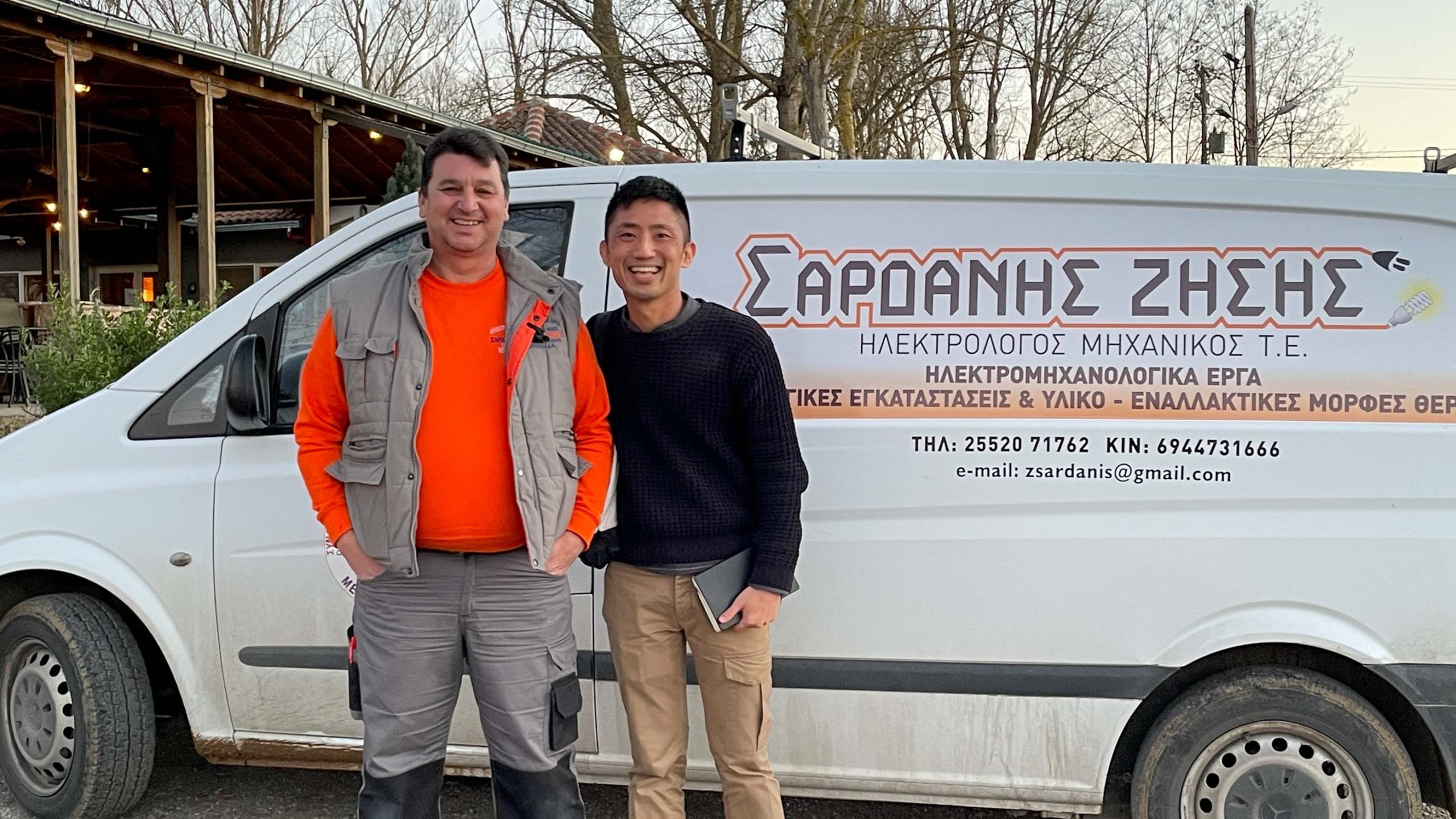
We stopped at the police operations center at the northern edge of the village to ask for permission to visit the fence. Usually, only farmers are allowed in that area, but Zisis had two reasons to be there: not only did he own fields right next to the fence but he also installed and maintained the security lights along the border. He told me that inside the center was a room filled with screens, where you could view live feeds from all the cameras along the fence.
As I waited in the car, I was struck by the massive armored vehicle parked beside me. I recognized it from an Associated Press article I’d read about new technologies that were being tested at the Evros border to prevent illegal crossings. In the article, a police officer operated a long-range acoustic device (LRAD) or “sound canon” attached to the top of the vehicle. The size of a small TV set, the LRAD could either be used to broadcast live or recorded messages across long distances or to produce a painful, high-frequency sound as loud as a jet engine to prevent people from approaching. The Greek police acquired two LRADs in late 2020.
In addition, the Hellenic Armed Forces is also set to receive 1,200 M1117 Guardian Armored Security Vehicles at no cost through the United States Excess Defense Article program. The first 44 M1117s arrived in Athens in December 2021, and it’s expected that some of the vehicles will be sent to Evros to patrol the Greek-Turkish border.
Beyond the last house in the village, we passed half-concealed bunkers and foxholes, then drove down a narrow dirt path, tightly fenced off and overgrown on either side, with signs warning about mines. Immediately after the minefield, the path crossed a deep, man-made canal that Zisis said was dug in 1973, right before Turkey invaded Cyprus. The canal was meant to trap tanks if Turkey tried to invade Greece. The defenses were physical proof of the deep distrust that still exists between the two countries.
When we reached the fence, it looked strangely beautiful, its five-meter steel bars reflecting the setting sun. The new fence had been built right behind the old, barbed-wire fence from 2012. As we bumped along the rutted dirt road, Zisis pointed out fields where the first green tendrils of garlic were sprouting and others where wheat had been planted in late fall. “See, I have real estate right next to Turkey!” he joked, showing me his plot of farmland.
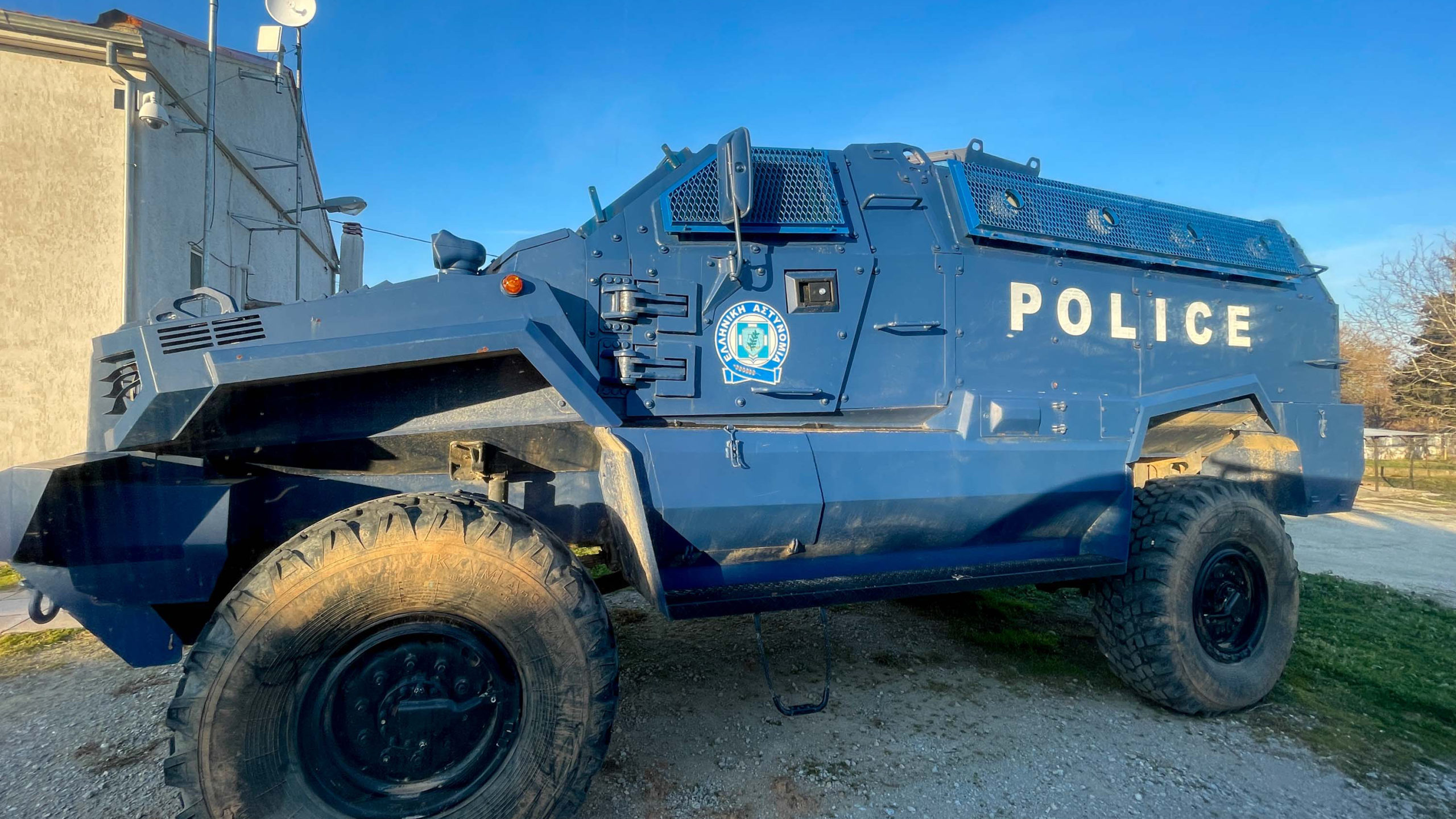
We drove west along the fence, and Zisis recounted how he had installed the security lights along the border in April 2020, over 15 days with his team. They were 300-watt LED flood lights, mounted on poles beneath thermal cameras aimed in three directions. Some of the cameras, he said, could penetrate five kilometers into Turkish territory. When the cameras detect a human heat signature, the lights automatically turn on and an alarm sounds, calling patrols to the scene.
Chrysovalantis Gialamas underscored the importance of the surveillance system: “The 11 pillars from north to south really are our eyes. This is a project that we’ve waited to be ready for more than 10 years.” He also praised the “essential” role of Frontex, the European Union’s border agency, which since 2020 has dispatched personnel, equipment, vehicles, thermal cameras and trained dogs. In August 2021, Reuters reported that Frontex was testing out camera-equipped Zeppelin balloons in Alexandroupoli to monitor Greece’s sea and land borders. The agency currently deploys some 60 standing corps officers to Evros as part of Joint Operation Terra 2022.
During our tour, Zisis and I met a group of German Frontex officers at the Arda River near Kastanies, accompanied by a Greek policeman. Later, he told me that while he believed the Greek police and army were well organized to protect the border, he appreciated Frontex’s presence in the region because as a European service, it could confirm Greek reports about the problems they witnessed.
The fortification of the Greek-Turkish land border is part of a larger trend of Europe militarizing its external borders. In an article titled “Weaponizing a River,” Ifor Duncan and Stefanos Levidis consider whether even the Evros River itself could be manipulated as “deadly defense architecture.” As I rode along the impenetrable steel fence, I wondered how it might look to someone from the other side. Next month, I will examine how the border crisis has toughened Greece’s stance toward migrants passing through Evros, putting human rights at risk.
On May 26, 2020, after a month of violent skirmishes, Turkish forces set fire to the makeshift migrant camp in Pazarkule and bussed the remaining migrants to quarantine facilities. The COVID-19 pandemic had begun in Europe, and Turkey and Greece shifted focus to their first lockdowns. Many migrants had come to Pazarkule believing Erdogan’s promise that the borders would be open and they could walk through freely. Some had spent their entire savings bringing their families here. Repulsed by the Greek side and disillusioned by the unsanitary camp conditions and worsening weather, Parvin, a 26-year-old Iranian woman summed it up well: “We are part of a game. They play with our bodies, with our minds, with our lives. It’s like a game.”
Top photo: The new, 12-kilometer steel fence that runs from the Evros River to the Kastanies border checkpoint was built behind the older and shorter barbed wire fence

